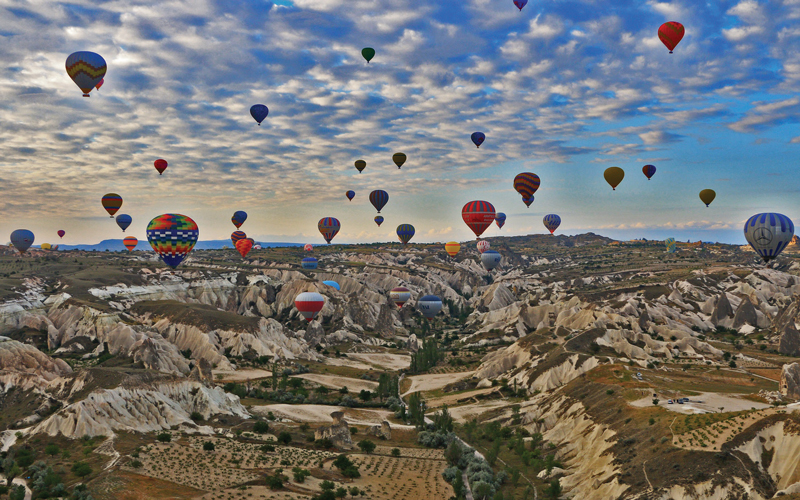Captivated By Cappadocia
Turkey’s Cappadocia is a Vermont-sized area of honey-colored “fairy chimneys,”

pinnacles of volcanic ash as much as 130 feet high that lost their lava coating centuries ago. Visitors view them on hikes, trek or ride horseback among them, or float above them in a hot air balloons.
In Cappadocia you can also visit Byzantine cave churches and monasteries in the Open Air Museum of Goreme, a UNESCO World Heritage Site. Decorating the cave walls are 9th-century frescoes and murals recounting Biblical stories and scenes from the lives of saints. Or, crawl through the passages of an underground escape city, constructed by Christians in the 6th and 7th centuries when Persian and Arab armies were attempting to drive the Christians away. More than 37 such cities have already been found, and there are expectations that as many as 100 more are still to be discovered.
Staying in a cave
Accommodations in Cappadocia are like nowhere else. For example, the elegant cave B&B called Sefa, meaning Freedom from Anxiety House, is in Ortahisar, a cobblestoned farming village known largely for its castle and its caves where citrus fruit is stored to ripen. Each of the two apartments in the American-owned B&B is tastefully furnished with Turkish antiques and includes a spacious bedroom, bath and small living room. One apartment has a terrace overlooking a valley of fairy chimneys. A substantial breakfast of fruits and cheeses, fresh-squeezed pomegranate juice (in season), yogurt, olives, tomatoes and cucumbers, fresh bread and tea is offered on the terrace of the owner’s apartment.
Call +90 384 343 23 51
Another small cave hotel is the five-room Serinn in the once-Greek village of Urgup, with views overlooking the village and the mountains. Owned by an Istanbul native, who has spent more than two decades in the airline and hospitality business, its inviting modern rooms were designed by a leading Turkish architect. Guests share the living room and library. A sumptuous breakfast, including home-baked goods, is served every morning on the terrace overlooking the mountains. For tranquility, Serrin would be hard to beat.
www.serinnhouse.com
A homey Urgup getaway, owned by Suha Ersoz, an environmentally conscious former lawyer, is the laid-back Esbelli Evi. Over the past 30 years, he has bought, renovated, and restored 15 houses with cave rooms. He has connected individual houses through stairs and tunnels, combined rooms of the houses to make suites and today, Esbelli Evi has nine suites and 4 classic cave rooms.
www.esbelli.com
The Yunak Evleri Cave Hotel is also in Urgup and its fifth- and sixth-century caves were occupied by local families until 1978. When the government built modern apartments elsewhere in town for these cave dwellers, they used their old homes for storage and for their animals. But when tourism to Cappadocia started to flourish, entrepreneurs began buying the caves and transforming them. Now six former caves houses make up this stylish hotel of 25 rooms and deluxe family suites. The suite bathrooms have either Swedish jet and steam showers or Jacuzzis. www.yunak.com
One of the earliest cave hotel complexes, Les Maisons de Cappadoce, is in Uchisar, long popular with French visitors to Cappadocia. Overlooking the Rose and the Pigeon Valleys, with craggy Uchisar Castle in the distance, Uchisar was happened upon in 1987 by French architect Jacues Aviziu. Entranced by the architectural possibilities he saw in the dilapidated caves there – just beginning to be sold – he bought several and his Maisons de Cappadoce began. Some apartments have full kitchens and living rooms with fireplaces; some rooms are more modest. All are imaginatively designed and furnished. There are also studio apartments for two that are ideal for honeymooners. One apartment has its own swimming pool. Breakfast is brought to each room mornings by a French serving staff. Beyond that, guests with kitchens may grill their own kebabs outdoors as the sun sinks over the valleys, or select a restaurant in town for dining. http://cappadoce.com
Argos in Cappadocia is built in a former 2,000-year-old monastery that later became a caravanserai on the Silk Route from China to Constantinople (now Istanbul). It has 42 guest rooms and suites in five different mansions. Most rooms have fireplaces. Antique Turkish rugs and furnishings brighten its accommodations. Suites have their own private pools. The hotel’s outdoor-indoor Seki Restaurant-Lounge is renowned for its stunning views of Pigeon Valley, for its local and regional dishes, and for its large wine collection. In midsummer, a Jazz program attracts neighborhood young and old, and the hotel’s spacious gardens are a sight to behold. Most of the vegetables served in the Seki Restaurant come from its own market gardens. It was in 1996 that this hotel had its beginnings when Gohsin Ilicali, a communication consultant in Istanbul and a real estate developer in Cappadocia, discovered its stunning site and hired an architect to transform nearly 40 abandoned houses into his hotel. Since its opening, Argos has won many prestigious travel industry awards.
www.argosincappadocia.com
Visit www.goturkeytourism.com




